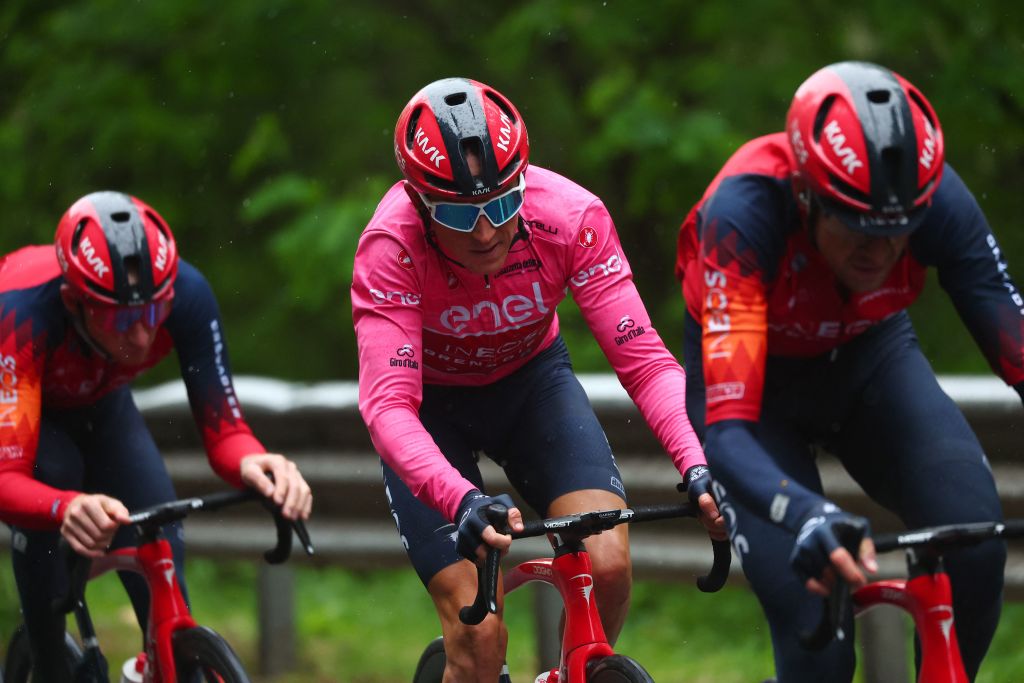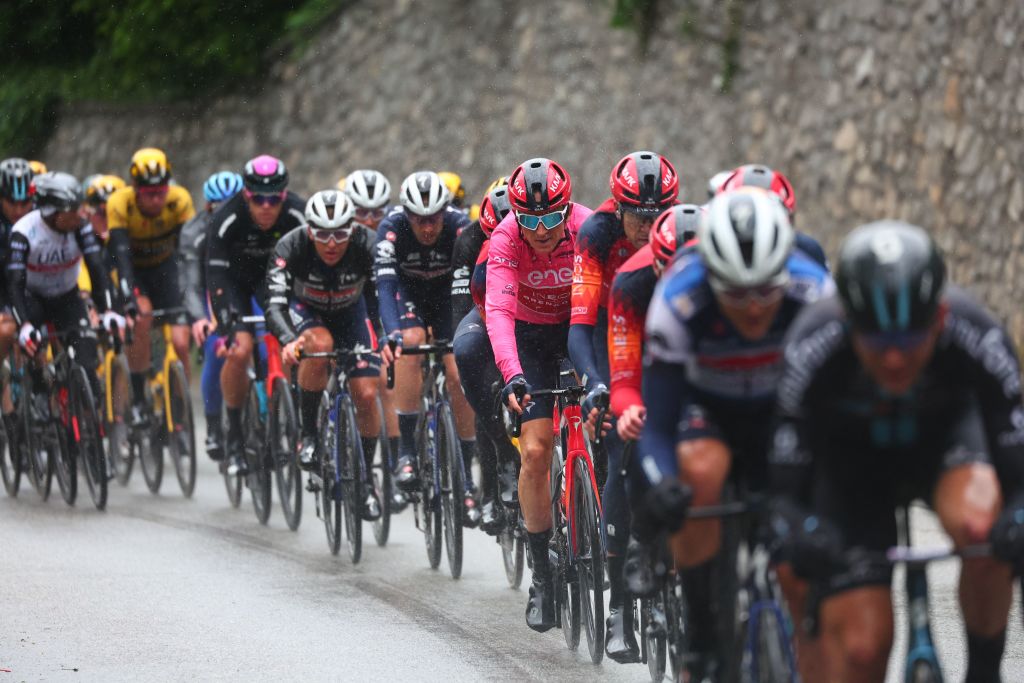Geraint Thomas: Giro d'Italia is totally different without Remco Evenepoel
Welshman remains two seconds ahead of Roglič after first day in pink

A sort of homecoming. Geraint Thomas’ first day in the maglia rosa of the Giro d’Italia brought him to Tuscany, where he spent some formative years during his cycling apprenticeship and through conditions more reminiscent of so many teenaged training rides in the hinterland of Cardiff.
“I left Wales when I was 20 to get away from the weather,” Thomas smiled after reaching Viareggio safely in the main peloton at the end of a sodden stage 10, his two-second lead over Primož Roglič (Jumbo-Visma) still intact.
Indeed, the conditions had been grimy enough to prompt a late conflab between the CPA and the Giro organisation about the prospect of cutting the stage short and avoiding the 1,527m-high Passo delle Radici. Although Thomas wears the pink jersey after Remco Evenepoel’s COVID-19 abandon, the Ineos rider played no part in the discussions at the start in Scandiano.
“We were happy to go with the consensus of the rider union, but we also had the mindset of doing the whole stage: we didn’t want to think about it being shortened because that just messes with your head, really,” Thomas said. “We were assured the conditions were good enough to race, and it proved that they were, so I’m happy we did it.”
Thomas inherited the lead of this Giro late on Sunday night when it was announced that Evenepoel had tested positive for COVID-19 and would leave the race with immediate effect. After entering the Giro’s first rest day with a deficit of 45 seconds in the overall standings, Thomas resumed on Tuesday with a narrow advantage over Roglič and Ineos teammate Tao Geoghegan Hart.
“I didn’t expect it coming into the race, because I’ve had a stop-start year, and I was expecting to sort of build into the Giro, so to have the jersey now is a big surprise. Obviously, the way I took it as well is not normal,” said Thomas, who gently deflated the idea that he might even have considered refusing to wear the maglia rosa for the first day after Evenepoel’s abandon.
“Not really. I think it’s respectful to the race to keep the jersey. Like I said yesterday, it’s not like he’s died or anything. Sometimes people don’t start races, and it’s definitely unfortunate how it happened, but I’m still here, and if somebody’s got to wear it, I’m happy to do that.”
Get The Leadout Newsletter
The latest race content, interviews, features, reviews and expert buying guides, direct to your inbox!
Ineos

The complexion of the Giro has changed utterly, of course, without Evenepoel. Before the race began, Thomas and his Ineos team would surely have expected to be trying to recoup a hefty deficit on the Belgian in the high mountains. Instead, the 36-year-old finds himself out in front even before the race’s entry into the Alps at the end of this week.
“I guess it changes a lot because everybody was talking about Remco and Roglič, and that was a battle we were kind of hoping to take advantage of, really,” Thomas said of Evenepoel’s absence.
“Now he’s not here, and it’s totally different. There are still a lot of good bike riders in the race, and it’s still super close, but there’s definitely a different element to it – including the fact that we’ve got the jersey now and we’re not looking to attack, at least in these next few days. We’ll see what happens on Friday.”
Instead of the anticipated Evenepoel-Roglič duel, this Giro is, for now at least, shaping up to be a contest between Ineos and the Slovenian, a neighbour of Thomas’ in Monaco. “Our sons play together, we’ve got a lot of respect for each other, and I guess our sense of humour is similar as well,” he said. “But when it comes to the actual race, when it matters, there’s no love lost.”
As well as Geoghegan Hart – third at five seconds – Thomas has three more teammates in the top 11 in the overall standings. The depth of his team is like no other on this race, and he dismissed the idea that their collective strength might be diluted by individual ambition.
“Maybe if there was egos and stuff, but in the team at the minute, there isn’t,” Thomas said. “At the end of the day, it’s going to be a massive advantage. If the start is chaotic and we have a couple of those guys in there, that can also be good.”
When Thomas crashed out of his last Giro appearance in the opening week in 2020, the episode seemed to mark the end of his career as a Grand Tour contender. He had, after all, been left out of Ineos’ Tour de France squad that year, and as cycling emerged from the COVID-19 lockdown, there was a growing sense that this was increasingly a young man’s game. Three years and another Tour podium finish later, however, Thomas is still part of the landscape.
“Never say never. I think when I won the Tour in 2018, to be honest, I thought I might have even stopped by now,” Thomas said. “But I didn’t have any plans, and I decided to take it year by year and you sort of keep going and the fact I’m still competitive and still able to compete for the GC is really nice. I guess I never really knew how I was going to go. But to still be here is great.”

Barry Ryan was Head of Features at Cyclingnews. He has covered professional cycling since 2010, reporting from the Tour de France, Giro d’Italia and events from Argentina to Japan. His writing has appeared in The Independent, Procycling and Cycling Plus. He is the author of The Ascent: Sean Kelly, Stephen Roche and the Rise of Irish Cycling’s Golden Generation, published by Gill Books.